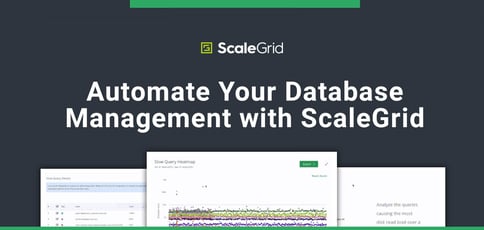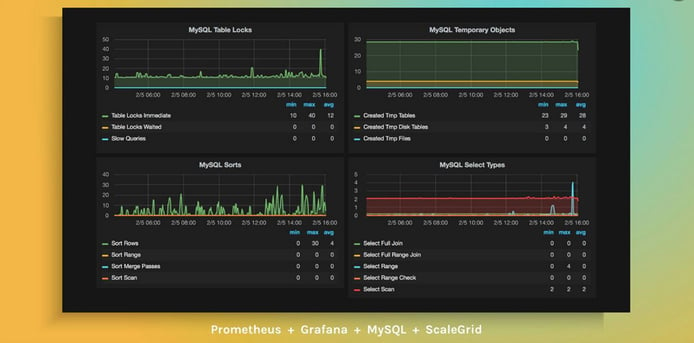
TL; DR: ScaleGrid has helped companies and developers manage and monitor their database infrastructure since its launch in 2012. Its fully-managed and automated solutions allow users to focus on their products while the ScaleGrid platform performs all of their operational database tasks. The company’s unique offering allows customers to seamlessly host databases, scale on demand, and, ultimately, save time and money.
Database management has always been a pain point for modern programmers. It’s no secret that most developers would rather focus on their application builds than the mundane tasks associated with monitoring, managing, and worrying about the scalability of their databases.
As a result, the global database-as-a-service market is estimated to see a CAGR of 18% between 2022 and 2033, according to MarketWatch.
And ScaleGrid is at the forefront of this industry, helping companies automate their database management and handle time-consuming operational tasks.

The company had its start in Seattle in 2012. That same year, ScaleGrid Founder Dharshan Rangegowda launched the first private cloud management solution that allowed users to run public cloud and on-premise databases on one platform.
ScaleGrid seeks to take the pressure off teams and allow them to focus on their priorities rather than running around trying to configure complex databases. Its services are fully-managed, which helps remove the burden of constant monitoring and manual installations.
“We handle all the operational aspects of running a production database. And the goal is for our software team to handle all of that so the customer can focus on the development side of things,” said Dharshan.
ScaleGrid operates in more than 100 countries and has reached 5,000 plus deployments. And the company figures can attest to its reliability and customer satisfaction as it has lost less than 1% of its customers.
Database management can be tedious, but ScaleGrid solutions help reduce time and money.
Deploy, Monitor, and Scale With ScaleGrid’s Managed Database
ScaleGrid offers three fully-managed database plans. Customers with cloud hosting accounts can purchase its lowest-priced plan and save with AWS or Azure Reserved Instances or GCP Committed Use Discount.
ScaleGrid also provides dedicated hosting for those without cloud infrastructure. Its database hosting is all-inclusive and sourced from top cloud providers, including AWS and GCP.
Its on-premise software package is ideal for companies with expert database administrators. Data professionals can use ScaleGrid to automate maintenance while they focus on deployment performance.
“There are tasks that still require human ingenuity, like schema design, Query Design, and index design. So in the long run, the device will handle all the base operational tasks while DBAs can focus on those high-value tasks,” said Dharshan.
ScaleGrid’s automated system monitors data, performs maintenance, and accounts for high availability disaster recovery, among other features. It keeps databases secured through OS patching and improves deployment performance with failover protection and minimal downtime.
Customers don’t need to worry about data transfer either. Data can migrate for free into their MySQL, PostgreSQL, Redis, or MongoDB database servers. Users can also retain admin control over their database clusters and scale data size to fit their demand needs.
Keeping Up with New Trends in a Fast-Changing Market
Dharshan said the database market had remained relatively stable over the years. But, in the last 10 to 15 years, the market has seen new trends take root. Companies have increased their adoption of no SQL databases and scenario-specific databases. Traditional relational databases, such as MySQL and Postgres, continue to dominate the market.
Dharshan said Postgres is probably the fastest growing database at the moment. He credits its functionality to its success. Postgres is an open-source database, which gives administrators more freedom to distribute and build within a community setting.
“MySQL, Postgres are not going anywhere. They’re continuing to do well with widespread adoption. Since Postgres is an open-source database, there’s a lot of community participation and energy, and it’s growing fast,” said Dharshan.
New databases have entered the market as well. CockroachDB, a distributed SQL database, has challenged the likes of Cloud Spanner by Google and has performed well.

As cloud adoption grows, developers will have less time to perform database administration tasks manually. They would rather spend their time storing procedures, writing codes, and designing schema. Dharshan said that’s why using automation for bottom DBA tasks has become a database-as-a-service trend in recent years.
“Nobody’s going to be provisioning servers and manually installing databases. All the automatable tasks will get automated as part of database as a service,” said Dharshan.
Luckily, with the ScaleGrid automated platform, companies and developers won’t have to worry about that. They can receive support for time-consuming database management processes and work on the development.
Leveraging Customer Feedback to Improve Development
According to Forbes, 77% of consumers view companies more favorably if they apply customer feedback, and 73% said good experience influences their brand loyalties. Since customer experience helps drive company success, client feedback is crucial to improving development and maintaining customer satisfaction.
Dharshan said ScaleGrid’s customer base consists of various backgrounds and demographics, which he says benefits the company. This factor helps the team learn about different client backgrounds, apply this information to their services, and expand its market reach.
“We have smaller customers running on DigitalOcean, Linode. And then, we have large enterprises running their servers in AWS, Azure, GCP, or on-premise. We get to work with customers across different sectors,” said Dharshan.
ScaleGrid leverages its varied client base to help improve its development processes. Dharshan said the ScaleGrid customers are opinionated and not afraid to share their thoughts on the services. He pointed out that the developers like to give feedback the most, which he is grateful for because the team can upgrade specific features tailored to customer needs.
Although customer feedback is prioritized, the ScaleGrid management team also watches the market to figure out where it’s heading and how to update its development efforts.
As for future plans, Dharshan said the team will branch out and expand its product listings. ScaleGrid now operates primarily on open-source technologies.
“We are starting to get into the commercial databases as we work with more large enterprises. So we are going to be adding support for SQL Server and Oracle standard,” said Dharshan.
HostingAdvice.com is a free online resource that offers valuable content and comparison services to users. To keep this resource 100% free, we receive compensation from many of the offers listed on the site. Along with key review factors, this compensation may impact how and where products appear across the site (including, for example, the order in which they appear). HostingAdvice.com does not include the entire universe of available offers. Editorial opinions expressed on the site are strictly our own and are not provided, endorsed, or approved by advertisers.
Our site is committed to publishing independent, accurate content guided by strict editorial guidelines. Before articles and reviews are published on our site, they undergo a thorough review process performed by a team of independent editors and subject-matter experts to ensure the content’s accuracy, timeliness, and impartiality. Our editorial team is separate and independent of our site’s advertisers, and the opinions they express on our site are their own. To read more about our team members and their editorial backgrounds, please visit our site’s About page.



